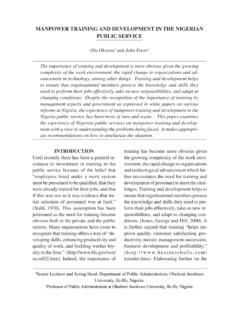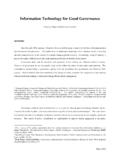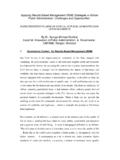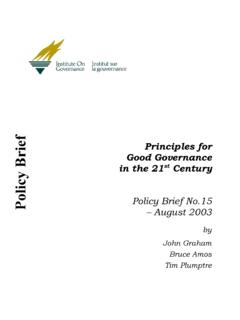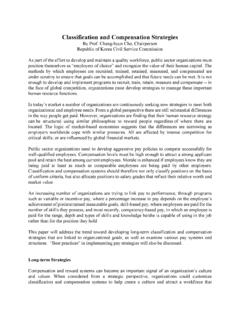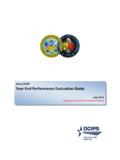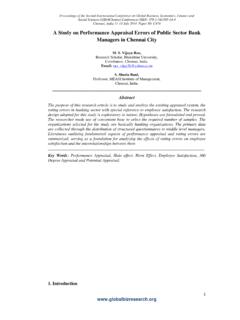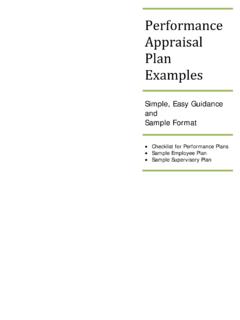Transcription of Performance Managementand Performance Appraisal in the ...
1 1 Performance Managementand Performance Appraisal in the Public Sector1 Pan Suk Kim Contents 1. Introduction 2. Performance Appraisal as Performance Assessment 3. Competency Framework 4. Incentives for Performance 5. Obstructions in Implementation of PRP Schemes and Strategies to Utilize PRP Schemes 6. Capacity Building through Education and Training. 7. Conclusions I. Introduction The purpose of this paper is to review and discuss public Performance management in general and Performance Appraisal and pay for Performance specifically. Performance is a topic that is a popular catch-cry and Performance management has become a new organizational ideology. Under the global economic crisis, almost every public and private organization is struggling with a Performance challenge, one way or another.
2 Various aspects of Performance management have been extensively discussed in the literature. Many researchers and experts assert that sets of guidelines for design of Performance management systems would lead to high Performance (Kaplan and Norton, 1996, 2006). A long time ago, the traditional Performance measurement was developed from cost and management accounting and such purely financial perspective of Performance measures was perceived to be inappropriate so that multi-dimensional Performance management was development in the 1970s (Radnor and McGuire, 2004). In fact, the term Performance management was not utilized until the 1970s (Armstrong and Baron, 2005).Since then, the language of Performance has become an almost every-day feature of work in many public sector organizations, in some form or another and the language of Performance has been associated with the establishment of standards or indicators to be achieved, and the audit of organizational systems to ensure conformance (Boland and Fowler, 2000).
3 In general, Performance management includes activities that ensure that organizational goals are consistently being met in an effective and efficient 1 This draft was prepared for delivery at the 2011 CEPA meeting in New York, April 4-8, 2011. 2 manner so that it involves shared vision, management style, employee involvement, incentives and rewards, competence framework, team work, education and training, attitudes, and dialogue. Brown (2005) notes many different reasons for introducing Performance management:(1) to provide information on organizational and/or employees effectiveness; (2) to improve organizational and/or employees effectiveness; (3) to provide information on organizational and/or employees efficiency; (4) to improve organizational and/or employees efficiency; (5) to improve employees levels of motivation; (6) to link employees pay with perceptions of their Performance ; (7) to raise levels of employee accountability; and (8) to align employees objectives with those of the organization as a whole.
4 Halachmi (2011) also provides a number of answers to the question of why measure Performance based on the statement made by the Interagency Working Group on US Government: (1) to demonstrate the results of program activities; (2) to show how these results support programmatic and organizational goals; (3) to determine what works and what doesn t; (4) to promote accountability and justify resource allocation; (5) to enhance the ability of managers to communicate with stakeholders; (5) to develop and strengthen partnerships among programs and organizations with similar goals and objectives; (6) to motivate and provide tangible feedback to employees; (7) to meet the requirements of related laws such as the Government Performance and Results Act.
5 The literature identifies the key features of a successful Performance management system as being: (1) alignment of the Performance management system and the existing systems and strategies of the organization; (2) leadership commitment; (3) a culture in which it is seen as a way of improving and identifying good Performance and not a burden that is used to chastise poor performers; (4) stakeholder involvement; and (5) continuous monitoring, feedback, dissemination and learning from results (Wang and Berman, 2001; De Waal, 2003; Franco and Bourne, 2003; Fryer et al., 2009). A crucial element of a Performance management system is Performance measurement monitoring that shows where change is required and which will in turn produce thedesired behavior that will produce improved Performance (Lemieux-Charles et al.)
6 ,2003; Fryer et al., 2009). Expertsoften use the phrases of Performance management and Performance measurement interchangeably, but two terms are somewhat different. Performance management is action, based on Performance measures and reporting, which results in improvements in behavior, motivation and processes and promotes innovation, whileperformance measurement is quantifying, either quantitatively or qualitatively, the input,output or level of activity of an event or process (Radnor and Barnes, 2007; Fryer et al., 2009). The primary function of Performance measurement is to specify broad and abstract goals and missions to enable evaluation and the main aspects of Performance measurement are: (1) deciding what to measure; (2) how to measure it; (3) interpreting the data; and (4) communicating the results (Wang and Berman, 2001; Fryer et al.
7 , 2009). 3 Generally, there are four steps in Performance management: (1) Performance planning (identification of Performance goals, confirmation of Performance responsibilities, and setting Performance indicators or Performance agreement); (2) Performance execution (execution of Performance goals, mid-year review and regular bookkeeping on Performance , accomplishment of Performance goals); (3) Performance assessment ( Performance evaluation , informing its result to each employee), and (4) Performance review and feedback. Among these steps, this paper focuses on Performance assessment in terms of Performance Appraisal for government employees. II. Performance Appraisal as Performance Assessment Performance management is an ongoing process that involves both managers and the employees in: (1) identifying the strategic vision, goals and objectives of the organization; (2) identifying and describing essential job functions and relating them to the mission and goals of the organization; (3) developing realistic and appropriate target standards of Performance ; (4) implementing ways of measuring actual, compared with target Performance ; (5) communicating constructive Performance evaluations; and (6) planning development opportunities to sustain, improve or build on employee work Performance (Neely et al.
8 , 1996). The Performance management process provides an opportunity for the employees and Performance manager to discuss development goals and jointly create a plan for achieving those goals. Development plans should contribute to organizational goals and the professional growth of the employees (Carney, 1999). However, it is not appropriate to elaborate all these steps of the Performance management system in this paper. This section focuses on the Performance assessment ( Performance Appraisal or Performance evaluation ) of overall Performance management. There are usually two levels of the Performance management system in the public sector: organizational-level Performance management and individual-level public sector.
9 For the organizational-level, each agency s overall Performance could be evaluated in terms of major policy execution, financial Performance , and other key areas (personnel, organization, e-government, quality of public service, etc.) using various indicators such as input, process, output, and outcome indicators (Kuhlmann, 2010). In order to assess organizational-level Performance , the balanced scorecard (BSC) approach isoften utilized in government (Kaplan and Norton, 1996, 2006). Organizational-level Performance assessment could be handled by the Office of the Prime Minister or the equivalent agencyin the central/federal government or a leading agency in cooperation with several agencies in the areas of finance, personnel, organization, auditing, e-government, quality of public service, etc.
10 However, discussion on organizational-level Performance assessment is beyond the scope of this paper. For the individual level, many countries might have some sort of Performance Appraisal (or Performance evaluation ) system in the form of Performance agreement, typical trait-ratingmethods, and/or 360-degree feedback as a supplementary evaluation . Individual-level 4 Performance assessment could be executed by the personnel authority of each agency and Performance of government employees could be evaluated regularly. Based on the result of Performance Appraisal , incentives cold be provided to government general, an incentive system is based on the motivation theory and motivation theory is characterized by a diversity of models and theoretical frameworks.

